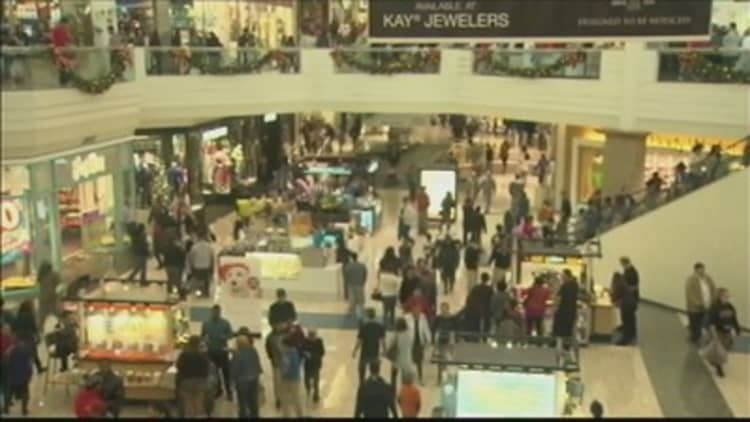After years of raunchy advertising and a slew of allegations against its former CEO, California-based American Apparel is ready to clean up its image.
Fresh off a win in U.S. bankruptcy court, during which a judge ruled in favor of the retailer's reorganization plan, the company's new chief is out to remind shoppers about what makes American Apparel unique: Its dedication to U.S. manufacturing.
To be sure, "Made in the USA" has been rooted in American Apparel's DNA since the company was founded 27 years ago. But CEO Paula Schneider, who took the company's reins one year ago, said that message had gotten lost amid some "salacious" advertising, and controversial headlines regarding founder Dov Charney.
Now, as it works to rebuild its business — which reported yet another sales decline on Monday — it's hoping a renewed interest in American-made products will bring shoppers back into its stores.
"We have the opportunity to keep people employed, and it's kind of a bit of call to action for people to come to shop," Schneider said. "It's a super important company and I think we have to call that out."
Roughly 7,500 of American Apparel's 8,700 employees work in Los Angeles, where it manufactures all of its apparel "right down to the strings that are in the hoodies," Schneider said.
Over the next few months, the company will up the ante on its "Made in the USA" promise, via a new a crowdsourcing campaign. Through this campaign, the retailer will invite local artisans to submit their designs to management, with the intention of bringing a yet-to-be determined amount onto its selling floor.
Schneider said this initiative will focus on accessories, as that's the only part of its business that is not American-made. Through this open call, the company's merchandise could eventually become 100 percent Made in the USA, Schneider said.
"I think that there's a really cool play to have this all made in the United States," she said.
Jack Trout, president of Trout & Partners marketing firm, called the brand's renewed push toward Made in America "a timely idea," as consumers become more interested in bringing back manufacturing.
A study by Consumer Reports last year found that almost 8 in 10 American shoppers would rather purchase a U.S.-made product than an import. And more than 60 percent said they're willing to pay 10 percent more for one of these products.
Joe Jackman, CEO of Jackman Reinvents, called American Apparel's position as a Made in the USA label "a strong point of difference." Its challenge, he said, is to amplify this message in a way that resonates with younger, value-oriented audiences, "while keeping a clear and compelling fashion point of view."
Indeed, the brand could use help persuading consumers to pay a premium price for its fashions. Much of American Apparel's struggles over the past few years have been attributed to the rapid growth of fast-fashion retailers, which have channeled its ethos of everyday staples, but at a much lower price. For instance, a basic tank top from American Apparel runs for $20 and $6 at H&M.

To better capitalize on consumers' frugality, Schneider said the company has implemented a "good, better, best" strategy. One example is using cheaper fabrics on designs that are likely to resonate with teenagers, and incorporating higher-quality materials on products meant for millennial mothers.
Still, the CEO contends that if the retailer designs better merchandise, shoppers will be willing to pay up.
"'Made in the U.S.' is more expensive, but our quality is better," she said. "It's not fast fashion because it lasts."
Other changes Schneider is making include rationalizing the number of units American Apparel produces — for example, reducing the number of men's T-shirt styles from 17 to four — and clearing up space on its crowded selling floor. In the stores that have piloted these changes, conversion — the ability to change shoppers into buyers — has gone up despite softer traffic.
The retailer has also closed 29 stores over the past year, for a total of 202 worldwide, and is experimenting with selling its brand via wholesale partners. It kicked off this initiative at Bloomingdale's Hawaii location in August, and the brand is now being rolled out to eight of the department store's doors. American Apparel currently generates about one-third of its revenue through a separate wholesale business, through which it produces unbranded apparel for other labels.
In spite of her plans, Schneider is transparent about the fact that 2016 will be a rebuilding year for the company, which filed for Chapter 11 bankruptcy protection in October.
On Monday, the retailer reported a net loss of $25.6 million during the quarter ended Sept. 30 — wider than its loss of $19.2 million during the same quarter last year. Meanwhile, sales came in at $126.1 million, down from $155.9 million a year ago.
"This is our year for stabilization," Schenider said.





